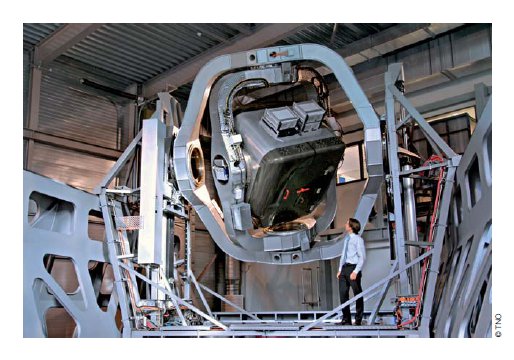I’m frequently reminded that I lead an interesting life. I got a particularly strong reminder last month, when I got to experience one of the world’s most advanced motion simulators — Desdemona.
Desdemona is a unique asset operated by TNO Netherlands Organisation for Applied Research in Soesterberg, southeast of Amsterdam. In a somewhat pathetic attempt to link this post to my day job, and to last month’s post, TNO is basically the “Fraunhofer Institute of the Netherlands.” As you can read on its website, Desdemona basically mounts a typical three-axis flight simulator on the arm of a centrifuge. The cabin has a modular layout that allows to be used as a fighter jet, a helicopter, a Boeing 737, a spacecraft or — and just as easily — as the interior of a car or the bridge of a small ship. It is mounted on a fully gimbaled system that is able to rotate around any conceivable axis. The system as a whole allows 2 meters of vertical movement, combined with 8 meters along a horizontal sledge. The sledge itself is able to spin as well. Centrifugal acceleration enables Desdemona to generate constant G-forces up to a maximum of 3 gravities.
In case you skipped over all that… inside Desdemona, you can control a full flight simulator experience while whirling around at the end of a centrifuge arm. Which makes it perfect for training astronauts.
Many of you know that I’ve been involved with XCOR, a small aerospace startup, for many years. I was the initial outside investor, and have been on the board since 2000. (Yes, it’s getting to be a very OLD startup. It’s not as small as it used to be, either.) XCOR has a contract with TNO to use Desdemona as part of its astronaut training package. XCOR has worked with TNO to program a sample suborbital mission, including high-G boost, a “sightseeing” period at the top of the arc where the participant can control vehicle orientation, and a high-G deceleration and landing. Since each of the board members will eventually fly on XCOR’s suborbital vehicle, we decided to take advantage of a board meeting in Amsterdam to experience the flight profile for ourselves. I cashed in a few vacation days for the trip… and it certainly was worth it!
The short version: it was a blast!
The slightly longer version: No, I did not get sick. Yes, it felt very much like what we expect from the real suborbital mission. (Actually, one of our test pilots estimates that the Desdemona simulation is slightly more stressful than the real flight will be.) Yes, I would happily do it again. And, yes, it made me even more anxious to fly into space myself.
The simulated mission begins and ends at Spaceport Curaçao. After a rocket-powered takeoff run, the spacecraft tilts vertical and you begin a steep climb through the stratosphere. After engine shutoff, you push the stick to bring the nose down; the simulated view from 100 kilometers up encompasses the entire Caribbean. After a few minutes of (simulated) weightlessness, you put the nose down and begin a steep descent, overflying Bonaire on the way back to Curaçao.
But if a picture is worth 1000 words, a video is worth 10,000:
The top left is, obviously, me. Usually grinning like a madman.
The top right is a shot of the Desdemona cabin whirling around.
The bottom left is an image of what the XCOR Lynx suborbital vehicle would be doing at each stage of the simulation.
The bottom right is only a portion of my field of view. The interior of the simulator gives you a full wrap-around image of the XCOR Lynx cockpit and the view forward, up, and to both sides. (No teensy little portholes for our spaceflight participants!) It looks off-center because I’m sitting in the right-hand seat; in the real vehicle, the pilot would be sitting to my left.
Not displayed, but being recorded by telemetry, was my heart rate… which peaked at 160 bpm during the re-entry (3.2 gravities).
It went quickly. The simulation is only a fraction of the length of a real suborbital mission. But even so, it seemed to go by in less than two minutes, not the nine minutes it really took.
Simulators are amazing tools, and a great way of engaging the kinesthetic senses (“seat of the pants” feeling) that we use to operate air or ground vehicles. Desdemona is more amazing than most, since it adds the acceleration to multiple gravities that would be experienced in a real mission. You quickly stop focusing on the “simulation” and focus on the experience.
But the real experience is going to be even better. Soon…



It is only a matter of time before virtual becomes reality. as technology advances the ability to create vitrual simulations becomes easier and more accessible for the average consumer. Automobile simulators and flight simulators are going to become more and more common but for what use…..Is it just to train people?? why wouldnt you want to train someone in the real element. by doing this you are just breaking down their ability to truely learn the skill themselves and they must conform to the way and style of the simulators.
You can create dangerous scenarios in the simulator and teach the individual how to deal with them with no risk. That’s very valuable.
That looks like a lot of fun! You definitely have me jealous (in a genuinely happy for you but wishing I could also get a Lynx flight sort of way).
~Jon
Well… all our employees get a flight. So either Altius makes enough money that you can buy a flight, or we go for Plan B. 🙂